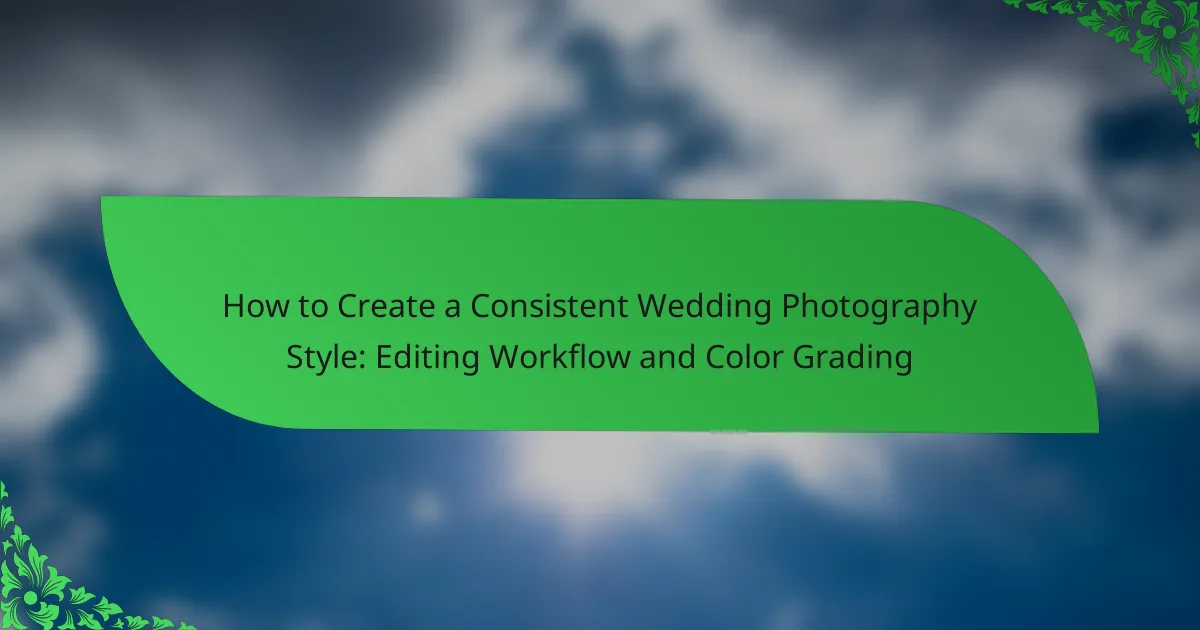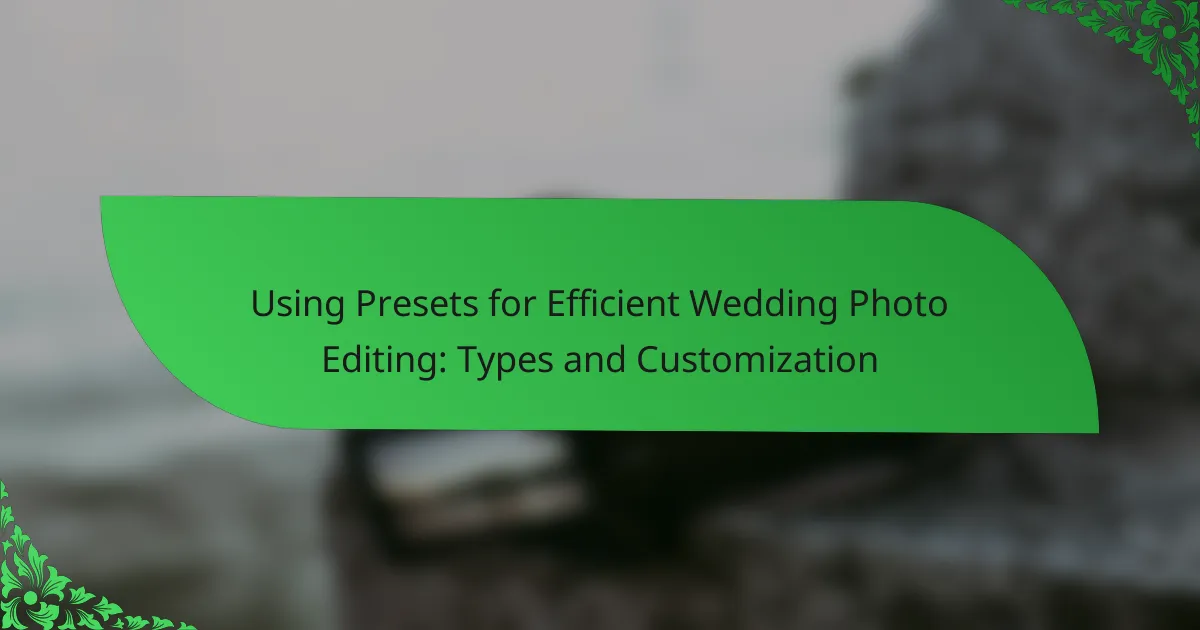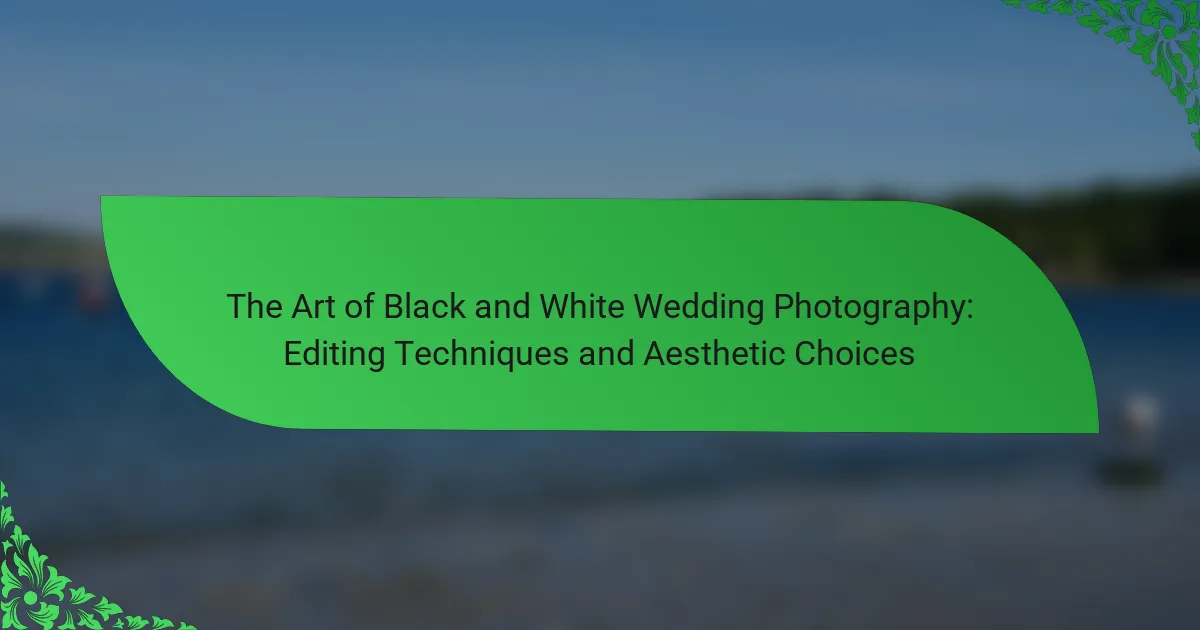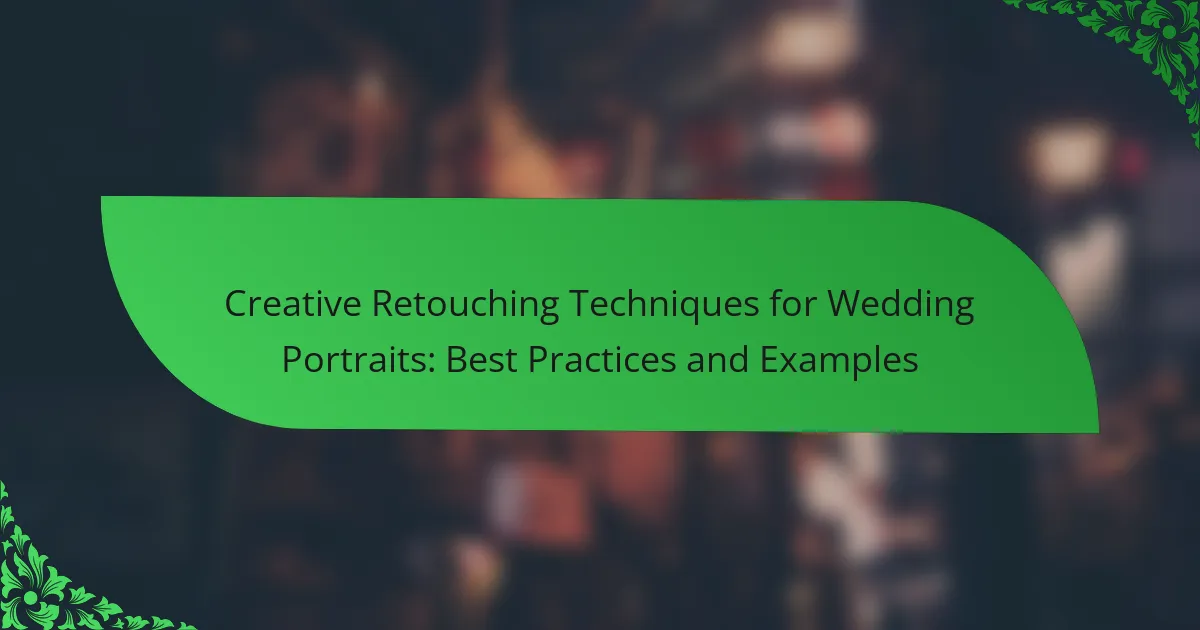Creating a consistent wedding photography style involves a unified visual approach that encompasses specific choices in lighting, composition, and editing techniques. This article outlines the essential steps in the editing workflow, including image importation, culling, basic adjustments, and color correction, ultimately leading to a professional final product. It also delves into color grading, a crucial process for enhancing the aesthetic and emotional impact of wedding images. By employing consistent style elements, photographers can strengthen their brand recognition and improve audience engagement.
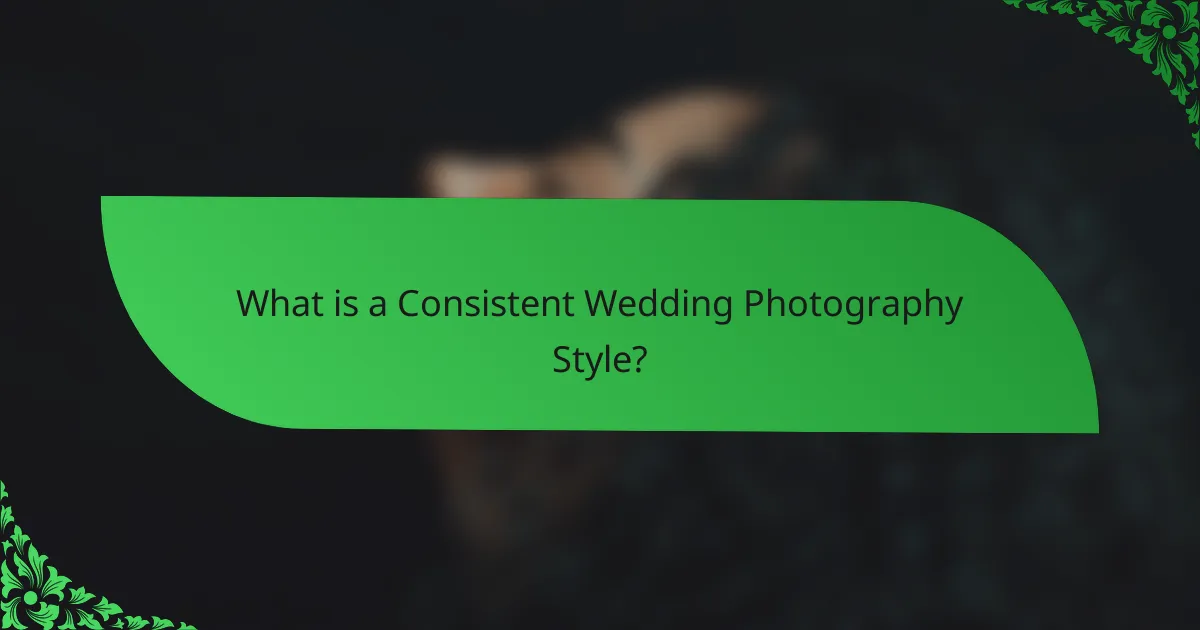
What is a Consistent Wedding Photography Style?
A consistent wedding photography style refers to a unified visual approach that photographers apply across all their work. This style includes specific choices in lighting, composition, and editing techniques. Consistency in style ensures that all images from a wedding convey a similar mood and aesthetic. Photographers achieve this by using the same camera settings and post-processing methods. For example, a photographer may favor soft, natural light and pastel color grading. This uniformity helps clients recognize the photographer’s unique brand. Studies show that consistent visual branding can enhance audience engagement and trust.
How does a consistent style enhance wedding photography?
A consistent style enhances wedding photography by creating a cohesive visual narrative. This coherence allows viewers to experience the emotions and story of the day more effectively. Consistency in editing and color grading establishes a recognizable aesthetic. It helps to unify images taken in different lighting conditions and environments. A well-defined style can also strengthen a photographer’s brand identity. This brand recognition can lead to increased client trust and satisfaction. Studies show that consistent visual styles can improve audience engagement by up to 50%. Ultimately, a consistent style elevates the overall quality of wedding photography.
What are the key elements that define a consistent style?
A consistent style in wedding photography is defined by specific elements. These elements include a unified color palette, consistent editing techniques, and a recognizable composition style. A unified color palette ensures that all images convey a similar mood and aesthetic. Consistent editing techniques involve applying the same filters or adjustments across all photos to maintain visual harmony. A recognizable composition style refers to the photographer’s unique approach to framing and capturing moments, which should be evident in every image. These elements work together to create a cohesive body of work that reflects the photographer’s artistic vision.
Why is consistency important in wedding photography?
Consistency is important in wedding photography because it creates a cohesive visual narrative. A uniform style helps to tell the story of the day in a harmonious way. It ensures that all images complement each other, enhancing the overall aesthetic. Consistency in editing and color grading leads to a recognizable brand identity. Clients expect a specific look that reflects their vision, and inconsistency can lead to disappointment. Studies show that cohesive portfolios attract more clients. A consistent approach also simplifies the editing process, saving time and effort. In summary, consistency enhances the emotional impact and professionalism of wedding photography.
What are the common characteristics of wedding photography styles?
Common characteristics of wedding photography styles include composition, lighting, and editing techniques. Each style emphasizes different aspects of these elements. Traditional wedding photography focuses on posed portraits and formal compositions. Photojournalistic styles capture candid moments and spontaneous emotions. Fine art photography often uses creative angles and artistic editing. Editorial styles resemble magazine shoots, featuring stylized poses and dramatic lighting. Ultimately, the choice of style influences the overall storytelling of the wedding day.
How do different photography styles influence the editing process?
Different photography styles significantly influence the editing process. Each style has unique characteristics that dictate specific editing techniques. For instance, portrait photography often requires soft skin retouching and color adjustments to enhance skin tones. In contrast, landscape photography may focus on enhancing natural colors and contrast to bring out details in the scenery.
Documentary photography editing usually emphasizes authenticity, minimizing alterations to maintain the original context. Fashion photography often involves dramatic color grading and creative effects to align with trends.
These stylistic differences necessitate tailored workflows in editing software. For example, Lightroom presets may be developed specifically for each style to streamline the editing process. The choice of editing tools and techniques directly aligns with the visual goals of each photography style.
What role does personal style play in wedding photography?
Personal style significantly influences wedding photography by shaping the visual narrative and emotional tone of the images. Each photographer’s unique approach affects composition, lighting, and color choices. Personal style helps convey the couple’s story and personality through the images captured. For instance, a photographer with a documentary style may focus on candid moments, while one with a fine art approach may emphasize artistic compositions. This stylistic difference can lead to varied emotional responses from viewers. According to a survey by WeddingWire, 75% of couples prioritize a photographer’s style when making their selection. Thus, personal style is essential in defining the overall aesthetic and impact of wedding photography.
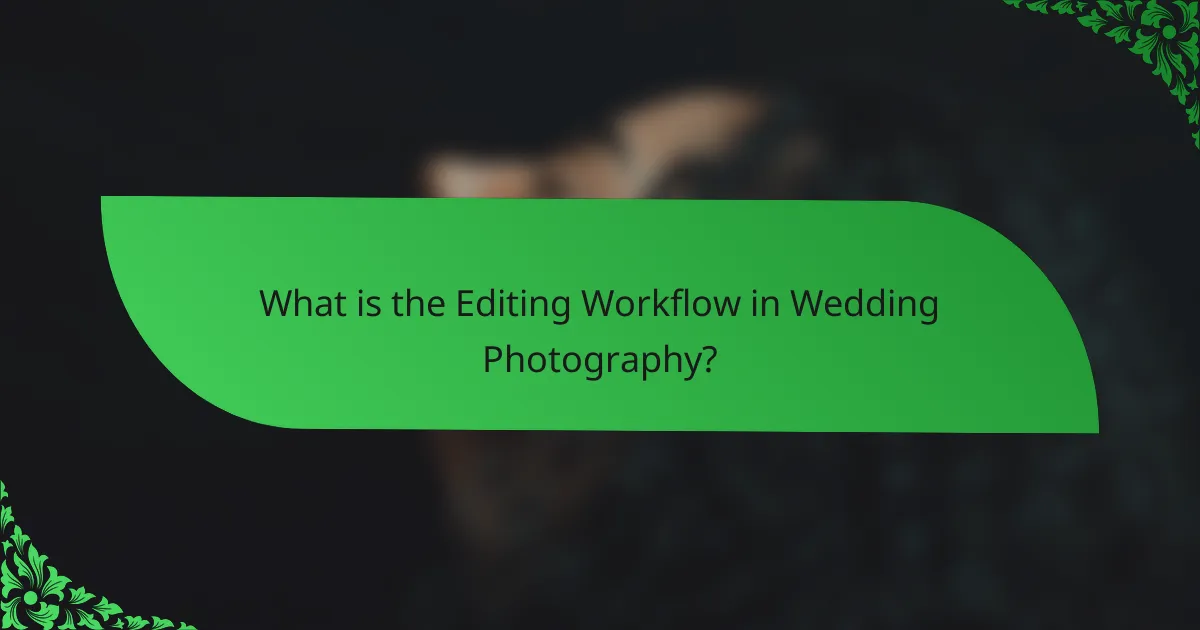
What is the Editing Workflow in Wedding Photography?
The editing workflow in wedding photography involves several key steps. First, photographers import images into editing software. Next, they cull the images to select the best shots. Afterward, they apply basic adjustments, such as exposure and contrast. Color correction follows to ensure accurate skin tones and vibrant colors. Then, photographers may apply creative edits, including filters or presets for a consistent style. Finally, images are exported in the desired formats for delivery. This structured approach ensures a professional and cohesive final product.
How do you establish an effective editing workflow?
To establish an effective editing workflow, start by defining clear steps in the editing process. Organize your photos into folders by date or event for easy access. Use consistent software for editing to maintain uniformity in style. Create presets to streamline color grading and adjustments across images. Allocate specific time blocks for editing to enhance focus and efficiency. Regularly back up your work to prevent data loss. Review and refine your workflow periodically to adapt to new techniques or software updates. These practices lead to a more efficient and consistent editing process in wedding photography.
What are the essential steps in the editing workflow?
The essential steps in the editing workflow include importing images, organizing files, and applying color correction. First, photographers import images into their editing software. Next, they organize files into folders for easy access. After that, color correction is applied to enhance the overall look. This involves adjusting exposure, contrast, and saturation. Following color correction, photographers often apply presets for a consistent style. Finally, images are exported in the desired format for sharing or printing. Each step is crucial for achieving a polished final product.
How can you streamline your editing process?
To streamline your editing process, establish a clear workflow. Start by organizing your files into designated folders for each shoot. Use software that supports batch editing to apply consistent adjustments across multiple images. Create and save presets for frequently used edits to save time. Utilize keyboard shortcuts to speed up navigation and editing tasks. Regularly back up your work to prevent data loss. Implement a review system to quickly identify and discard unusable images. These methods enhance efficiency and consistency in your editing process.
What software tools are commonly used for wedding photography editing?
Adobe Lightroom and Adobe Photoshop are commonly used software tools for wedding photography editing. Lightroom offers powerful photo management and editing features. It allows photographers to organize, edit, and export images efficiently. Photoshop is ideal for detailed retouching and advanced editing. Many photographers use both tools in tandem for optimal results. Capture One is another popular choice, known for its color grading capabilities. It provides a professional editing environment for high-quality images. Other tools like Skylum Luminar and ON1 Photo RAW also cater to wedding photographers. These tools help enhance images and maintain a consistent editing style.
How do different software options compare in functionality?
Different software options for wedding photography editing vary significantly in functionality. Adobe Lightroom offers advanced organizational tools and robust editing features. Capture One provides exceptional color grading capabilities and tethering options for studio shoots. Photoshop excels in detailed retouching and compositing, allowing for intricate edits. Each software has unique strengths tailored to specific editing needs. For instance, Lightroom’s user-friendly interface is ideal for batch processing. In contrast, Capture One’s color fidelity is favored by professional photographers. These differences highlight how each software serves distinct editing workflows in wedding photography.
What features should you look for in editing software?
Look for features like user-friendly interface, robust editing tools, and file format compatibility in editing software. A user-friendly interface enhances workflow efficiency. Robust editing tools include options for color correction, cropping, and retouching. File format compatibility ensures the software can handle various image types. Additional features like batch processing save time during editing. Cloud storage integration allows for easy access and backup. Customizable presets help maintain a consistent style across photos. Regular updates and customer support are essential for ongoing usability.
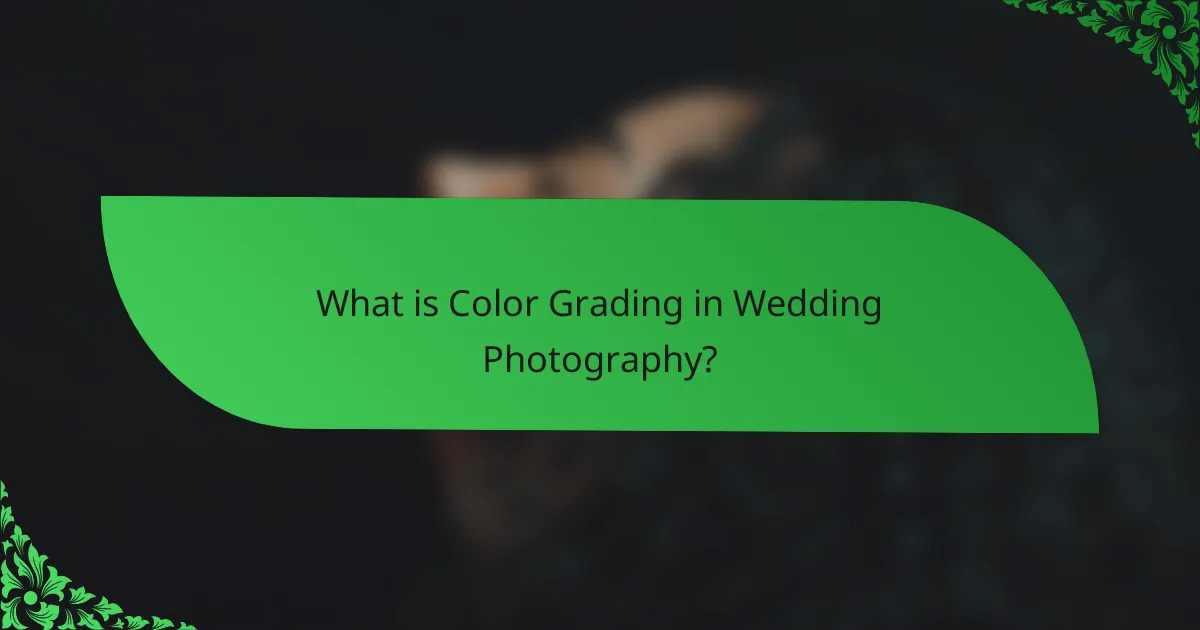
What is Color Grading in Wedding Photography?
Color grading in wedding photography is the process of adjusting the colors and tones in images. This technique enhances the overall aesthetic and mood of the photographs. Photographers use color grading to create a consistent style across a wedding album. It involves manipulating various attributes like hue, saturation, and brightness. The goal is to evoke specific emotions and highlight important moments. Color grading can transform ordinary images into visually striking ones. Many photographers employ software tools like Adobe Lightroom or Photoshop for this process. Studies show that well-executed color grading can significantly impact viewer perception and emotional response.
How does color grading affect the overall look of wedding photos?
Color grading significantly influences the overall look of wedding photos. It alters the mood, tone, and aesthetic appeal of the images. Different color grading techniques can evoke various emotions. For example, warm tones may create a romantic atmosphere. In contrast, cooler tones can lend a modern or moody vibe.
Color grading also enhances the visual consistency of a photo series. This consistency is crucial for storytelling in wedding albums. By applying a specific color palette, photographers can unify diverse scenes. This approach helps maintain a cohesive style throughout the collection.
Studies show that color grading can affect viewer perception and emotional response. Research indicates that colors impact feelings of happiness and nostalgia. Therefore, effective color grading can enhance the viewer’s connection to the wedding memories captured.
What are the different color grading techniques used in wedding photography?
The different color grading techniques used in wedding photography include the following: Split toning, which involves adding different colors to highlights and shadows. This technique creates a unique look and enhances mood. Another method is the use of presets, which are pre-defined settings that achieve a consistent style quickly. The use of curves is also common; it allows photographers to adjust brightness and contrast precisely. Color blocking is employed to emphasize certain colors while muting others, creating a striking visual impact. Lastly, desaturation techniques can be used to create a more timeless and classic feel by reducing vibrant colors. These techniques collectively help in establishing a cohesive aesthetic in wedding photography.
How can color grading enhance emotional storytelling in photos?
Color grading enhances emotional storytelling in photos by adjusting hues and tones to evoke specific feelings. It allows photographers to create a mood that aligns with the narrative of the image. For instance, warmer tones can evoke feelings of happiness and intimacy. Conversely, cooler tones may convey sadness or nostalgia. Studies show that color can influence viewer perception and emotional response significantly. Research indicates that images with intentional color grading are more likely to resonate emotionally with viewers. This technique can help create a cohesive visual style in wedding photography, enhancing the storytelling aspect.
What are the best practices for color grading in wedding photography?
The best practices for color grading in wedding photography include maintaining consistency, adjusting white balance, and enhancing skin tones. Consistency across images creates a cohesive look for the wedding album. White balance adjustments ensure that colors appear natural and true to life. Enhancing skin tones is essential for flattering portraits. Utilize color grading tools to achieve desired moods, such as warmth or coolness. Pay attention to the color palette of the wedding to harmonize the images with the event’s theme. Use presets or custom settings to streamline the editing process while ensuring quality. Regularly review and refine techniques to stay updated with trends in wedding photography.
How do you create a cohesive color palette for your wedding photography?
To create a cohesive color palette for wedding photography, start by selecting a base color that reflects the couple’s theme. Choose complementary colors that enhance the base color without overwhelming it. Use color theory principles, such as the color wheel, to identify harmonious combinations. Consider the venue and lighting conditions, as they influence how colors appear in photographs. Create a mood board with sample images to visualize the palette in context. Test the palette during a pre-wedding shoot to see how it translates in various lighting. Adjust the colors as necessary based on the results. This method ensures a consistent and pleasing aesthetic throughout the wedding photography.
What common mistakes should be avoided in color grading?
Common mistakes to avoid in color grading include over-saturation, inconsistent color balance, and neglecting skin tones. Over-saturation can lead to unnatural colors, making images look unrealistic. Inconsistent color balance can create a disjointed visual experience across a series of photos. Neglecting skin tones may result in unflattering appearances for subjects. Additionally, failing to use reference images can hinder achieving a cohesive look. Ignoring the context of lighting conditions can also lead to poor results. Lastly, not utilizing software tools effectively can limit color grading potential. These mistakes can detract from the overall quality of wedding photography.
What tips can help you achieve a consistent wedding photography style?
To achieve a consistent wedding photography style, establish a defined editing workflow. This workflow should include a set of presets that reflect your artistic vision. Use the same color grading across all images to maintain uniformity. Consistency in lighting and composition is also crucial; aim for similar settings and angles throughout the event. Develop a signature style that resonates with your brand identity. Review and refine your portfolio regularly to ensure alignment with your desired aesthetic. This approach will help solidify your unique photographic voice.
The main entity of the article is ‘consistent wedding photography style,’ which encompasses the unified visual approach that photographers apply across their work. The article outlines essential elements such as lighting, composition, and editing techniques that contribute to a cohesive aesthetic, enhancing the emotional impact of wedding photography. It also details the editing workflow, including steps for organizing and processing images, and emphasizes the importance of color grading in creating a consistent visual narrative. Additionally, the article discusses common characteristics of various photography styles and best practices for achieving a recognizable and professional brand identity in wedding photography.
